Tattoo Removal
Tattoo has been a tribal culture since the ancient time, expressing ones identity, or sentiment. There are great varieties, including the sites of tattoo, the sizes, colours, and patterns.
Tattoo Colours
Amateur tattooing can be performed with any sharp object and any type of colouring agent, although mainly in black, with charcoal material.
Professional tattooist uses a personal secret recipe of colours, mostly Indian inks, for less incidences of adverse reactions. This is pierced by a tattoo machine into the skin, about 1mm to 3mm deep. The colour agents they use are many, and the colours are due to metallic composition. There are:
- Blue (contain Cobalt aluminate)
- Brown (contain Ferric oxide and Lime)
- Green (contain Chromium oxide)
- Red (contain Cadmium sulphate and Mercury sulphate)
- Violet (contain Manganese)
- White (contain Titanium dioxide and Zinc oxide)
- Yellow (contain Cadmium sulfide)
There is inflammation and scabbing after the tattooing, and the scabs come off after about 2 weeks. The colour agent will be distributed over different levels of the skin, mainly around the small blood vessels, or is engulfed by the cells called macrophages. About 30% of the agent will be removed in the first few days, the rest will permanently reside in the fibroblasts cells.
The fading of tattoo depends on multiple factors:
- Stability of the colour agent (charcoal black is more stable than yellow or red)
- Technique of the tattooing (the deeper one will last longer)
- inflammation (chronic inflammation may eradicate the colour completely)
Complications
- Infections, including bacteria, hepatitis viruses, HIV
- Allergy, mainly to the mercury salt in red colour
- Scars, including the hypertrophic and keloid scars.
Methods Of Removal
Many people regret about their tattoo and seek removal, for different reasons. In the
past, lots of methods were tried:
- Chemical agents
- Dermabrasion
- Surgical excision
- Cryo-therapy
- CO2 Laser abrasion
Laser Removal
Pigment laser is by far the most effective method in its removal. Although there are many such lasers, there is not a single one with a wavelength that can remove all different colours. In treating a multi-coloured tattoo, few different lasers may be necessary.
- Ruby Laser (694nm) and Alexandrite Laser (755nm): good for blue and black, but not able to remove red and orange.
- Nd-YAG Laser (1064nm): good for blue, black, not for green, red and orange
- Pulse Dye Laser (510nm) and Double Frequency Nd-YAG Laser (532nm): fairly good for red and orange
Multiple treatments are necessary, each separated by about 8 week. The number of treatment varies from 2 or 3, to 10 or 12. No one can predict the response of the tattoo accurately, and at the end, not 100% of the colour may be removed. Amateur tattoo is usually more superficial and so is easier to be removed. The treatment is moderately painful and topical anaesthetic cream is necessary for 1 hour before treatment. The skin will be red and swollen for a few days after, and return to normal in about 7 days.
Some cosmetics may stain the skin like a tattoo, and can be removed similarly with laser. However, for almond, white, light pink or light brown colours, laser treatment may paradoxically make them turn black permanently.
For dark skin individuals, ruby and alexandrite lasers may burn the superficial skin, leaving either a darker or lighter mark. The chance of scarring from laser treatment is very low and happens only very rarely.
Treatment Examples <
| Eye Brows |  |
 |
|
Before
|
After 2 Treatments
|
|
 |
 |
|
|
Before
|
After 2 Treatments
|
|
| Eye Lines |
 |
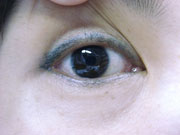 |
|
Before
|
After 1 Treatment
|
|
| Black Tattoo |
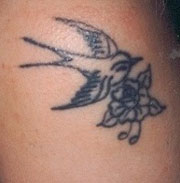 |
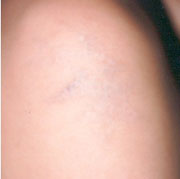 |
|
Before
|
After 6 Treatments
|
|
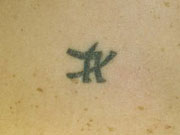 |
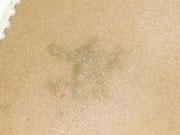 |
|
|
Before
|
After 3 Treatments
|
Red & Blue Lines Removal
Small dilated blood vessels, when seen throught the skin, appear as red or blue lines. We called them telangiectasia. They can be seen anywhere on the body but are more common on the face and legs.
It is discussed in more details at: Aesthetic Medicine > Aesthetic Problems > Telangiectasia (Red & Blue Lines)
How Does It Work?
The blood pigment, called haemoglobin inside the blood vessels, acts as the chromophore to attract the laser. Some wavelengths are attracted more than the others, as explained earlier under <What Is Lasers>. This selective photo-thermolysis process generates heat which closes up the blood vessels.
We use the GentleYAG laser, which is a long-pulsed 1064nm machine. This wavelength is less absorbed by the melanin pigment in the skin, and so will cause less chance of skin burning. Moreover, it has a patented Dynamic Cooling Device, which sprays a short purge of cryogen just before the laser emission, and therefore offers extra protection and comfort during the treatment.
Treatment Procedures
You will find the treatment only slightly painful, because of the Dynamic Cooling Device. As local anaesthetic cream may blanch the blood vessels and make treatment difficult, it is not applied before the treatment.
The treatment is rather time consuming. The laser is traced along the individual blood vessels. There is immediate clearance of the vessels, but later some of them will re-emerge, but in less extent. There is only minimal redness and swelling overlying the vessels, and as this subsides in a few days, the underlying vessels are not seen anymore, or at least much reduced in size.
Multiple treatments are usually required. Those on the face are more readily removed comparing to those on the legs. Capillary telangiectases (red lines) are more resistant than venous telangiectasia (blue lines), and can persist or return quickly after laser treatment.
Treatment Examples
| Facial Telangiectasia |
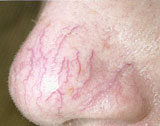 |
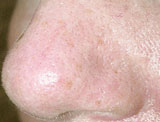 |
|
Before
|
After 1 Treatment
|
|
| Facial Blue Vein |
 |
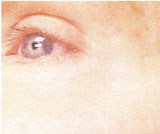 |
|
Before
|
After 1 Treatment
|
|
| Leg Telangiectasia |
 |
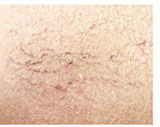 |
|
Before
|
After 1 Treatment
|
Birthmark Removal
The usual birthmarks one will encounter in aesthetic treatment is either:
- dark brown to black, such as the Naevus of Ota and the Café-au-lait spots, or
- red, such as the Strawberry Navei and the Port Wine Stain.
These are discussed in details at: Aesthetic Medicine > Aesthetic Problems.
Basically the black birthmarks are due to melanin, and are treated with lasers similar to cases of other black-pigmented problems, such as freckles and solar lentigines. The red birthmarks are due to abnormally dilated blood vessels, and are treated with lasers similar to cases of telangiectasia.
Naevi Of Ota
This usually occurs on the upper and middle third of one side of face. The ears, inside of mouth, and the sclera of the eyes can also be affected. The colour ranges from bluish gray to dark brown.
The melanin and melanocytes are found deep in the dermis and laser treatment is the only hope for fast and effective clearance.
The most effective laser so far is the Q-switched 755nm or 1064nm. Even so, many sessions, frequently up to around 10, are required to clear it enough not to be noticeable. Each treatment is spaced about 8 weeks apart. Therefore to completely remove this, it may require up to 2 to 3 years, and patience and determination is a must. This should be considered thoroughly before committing to the whole series of treatment.
The treatment is painful and topical local anaesthetic cream is applied for 1 hour before the treatment. For areas near the eye margins, local anaesthetic injections may be used. The skin can be quite red and swollen after, and cold compress will help to sooth the skin. It will return to normal after about 1 week. The chance of any complication is very rare, and it does not cause scars normally.
The colour will slowly fade away after each treatment. Sometimes there is not much change until 2 treatments are performed. At the end there may still be a vague hue on the skin, but that is usually coverable with make-ups. Recurrence is not uncommon after a few years.
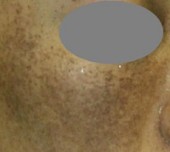 |
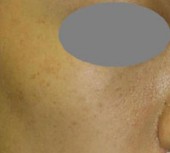 |
|
Before
|
After 10 Treatments
|
Café-au-lait Spots
Café-au-lait spots are flat, light tan to brown colour. Their sizes are very variable, from 2cm to 20 cm in diameter. They may appear at birth or soon after and increase in numbers in subsequent years.
Laser treatment is very effective. Again a Q-switched 532nm, 755nm, or 1064nm can be used. However, the response to laser can be variable. Sometimes 2 treatments can remove the spots completely, while other cases may need 5 or 6 treatments.
Similarly, there is some redness and swelling after, but will resolve after 2 or 3 days, and the skin will be normal looking again after 1 week. The melanin pigment is shattered inside and removed gradually from within.
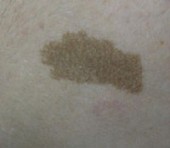 |
 |
|
Before
|
After 2 Treatments
|
Strawberry Naevi
Strawberry naevus is caused by an abnormal growth of excessive blood vessels near the surface of skin. It usually appears in the first few weeks of life, starting as a small, soft raised swelling, and can grow rapidly to become large and appear bright red, like a strawberry.
Usually if it does not interfere with breathing or vision development, it is left for natural regression when the child grows up. However, if complications occur, or if there is residual left over after the maximal regression, laser treatment can be used.
In babies and small children, general anaesthesia would be required. In older children with small leftover lesion, local anaesthetic cream can be used instead.
The laser used include a pulsed dye laser, KTP laser, and the GentleYAG long-pulsed 1064nm laser. Multiple treatment again would be necessary and the number of treatment can be quite variable.
Port Wine Stain
Port wine stain is another birthmark of the vascular nature. The face and upper trunk are the most common sites. It is due to the blood vessels being kept open abnormally and this shows up as a permanent blush in pink, red, or purple.
Unless strawberry naevus, port wine stain persists through out life and enlarges together as the body grows in size. Left untreated or in pronounced cases, it can turn darker in colour and become thickened, and lumpy formation is common.
Treatment is varied and the pulsed dye 585nm laser can be effective, with a low risk of complications. It usually requires multiple treatments, and may not clear completely. Depending on the size and site, responses can be quite different. Port wine stains on the limbs respond less well than those on the face. Treatment is more successful when given early in life, before the birthmark becomes thickened.
There are reports, which show that thickened lumpy cases can also be effectively treated with the GentleLASE long-pulsed 755nm laser and GentleYAG long-pulsed 1064nm laser. Despite the less absorption by blood pigment, it is compensated by the abundant presence of this targeted chromophore in the more pronounced cases. Another added advantage is the patented Dynamic Cooling Device, which fires a short burst of cooling cryogen onto the skin prior to the laser pulses, ensuring adequate skin protection, the consistency of treatment, and maximal patient comfort.
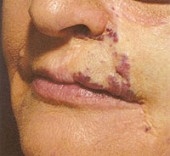 |
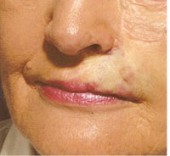 |
|
Before
|
After 3 Treatments
|

